Thank you to everyone who ordered Offcut notebooks: they sold out in three days.
Here’s a stack of envelopes ready for posting to Charlottetown, Stratford, Halifax, Toronto, Calgary, and The Netherlands.
They were a delight to produce, and I’m proud to have them fly away.
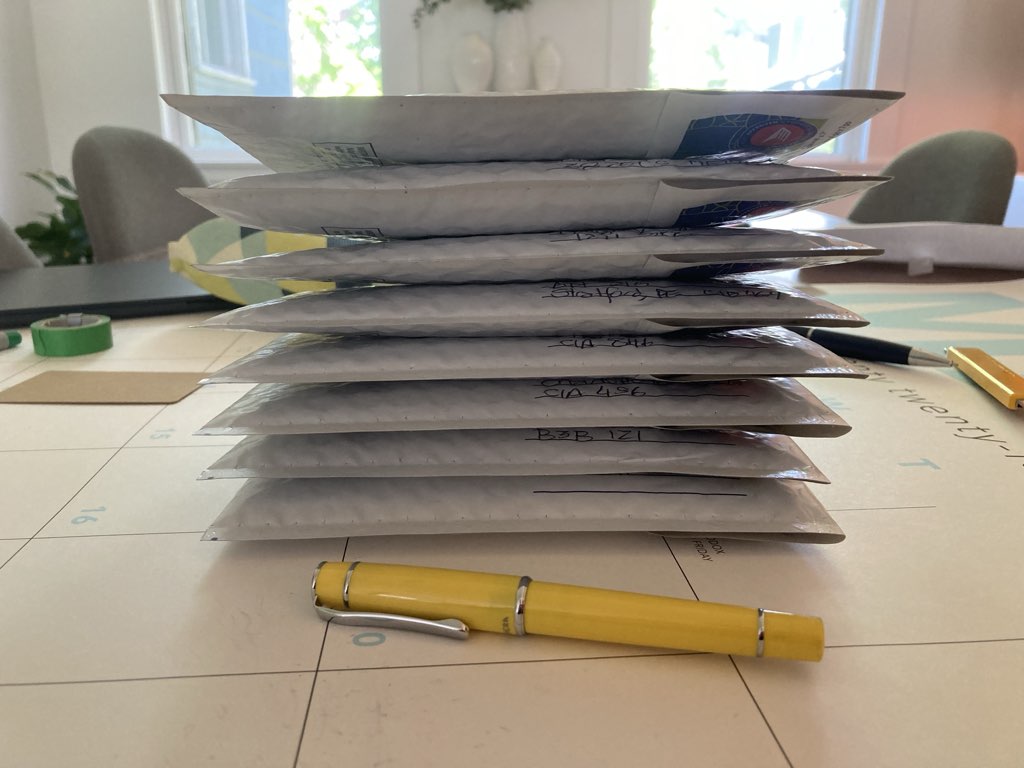
Part of our monthlong trip to Europe this spring was a five day printmaking residency at Two Cents Press in the small Tuscan village of Serrazzano.
We stayed in an apartment above the printshop, and, with the help of Two Cents’ proprietor Franco Marinai, threw ourselves into producing an edition of our This Box is for Good series, something I’ll write more about soon.
Left on the cutting room floor when we were done were pieces of beautiful Magnani Pescia paper. I couldn’t bring myself to leave them there. So, in the waning hours of our residency, I turned them into an edition of 10 small notebooks, printing the cover with offcut on the Two Cents letterpress shop using a font of wood type. Magnani Pescia paper is otherworldly: it’s made of 100% cotton, and while it’s recognizably paper, it feels and folds unlike any paper I’ve ever encountered. I love it.
Magnani paper was produced at mills in the village of Pescia, not far from Lucca, from 1404 until 2014, when circumstances, including a landslide on the road into the village, led to its untimely end. Franco purchased this paper many years ago, from original stock, and so in addition to being otherworldly, it’s also a relic of a 610 year old paper-making tradition.
Today I finished hand sewing the notebooks, and I’ve posted them in the Queen Square Press shop for sale (update: sold out!), pricing them at $14.04 because, well, of course.
As I wrote in the product description there, “they are ’perfectly imperfect,’ an improvised rush job to rescue some lovely paper.” While I love the boxes we produced in Serrazzano, I love these notebooks too; I’ve a soft spot for projects the come together in a flurry at the last minute.
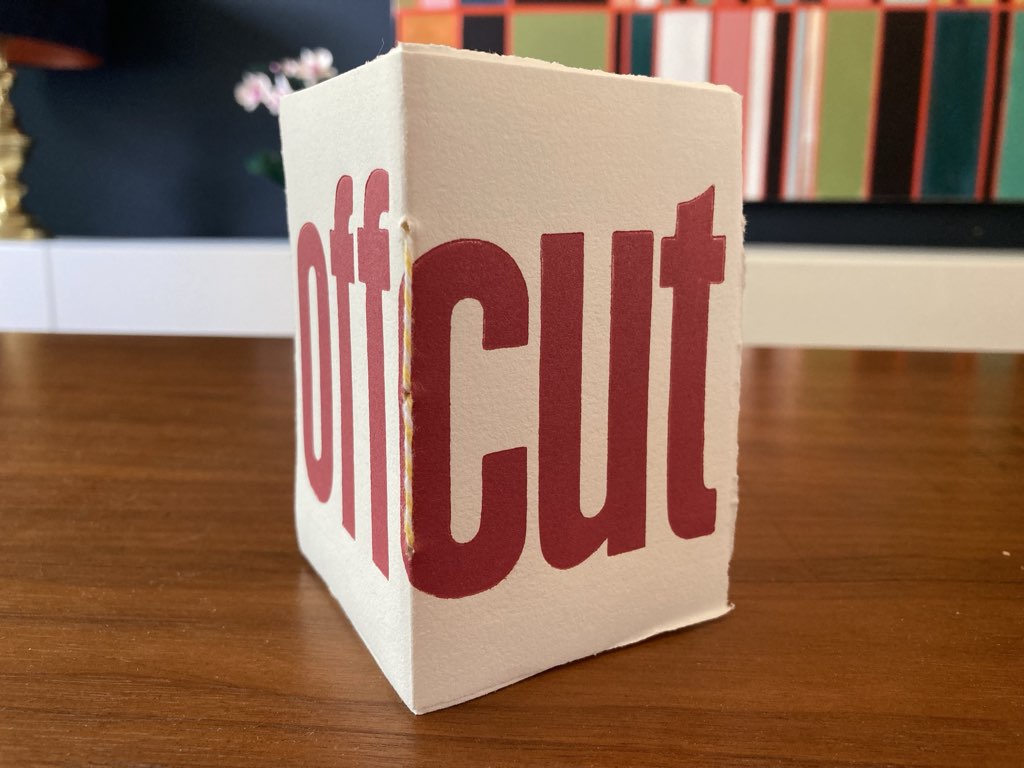
Seven years ago my friend Judy pointed me to Robin Sloan’s Mr. Penumbra’s 24 Hour Bookstore: “I just read a book that made me think of you, in a bunch of ways,” she wrote.
Judy was right. I bought the book, and the next, and became, in so doing, a card-carrying Robin Sloan fan.
His newest book, Moonbound, was just released, and my copy arrived at The Bookmark as scheduled.
Here’s a photo I took on this day, five years ago, May 31, 2019, at Dharma Sushi in Halifax. We’d just rendezvoused with Olle and Luisa, freshly arrived from Sweden, in advance of the Crafting {:} a Life unconference.
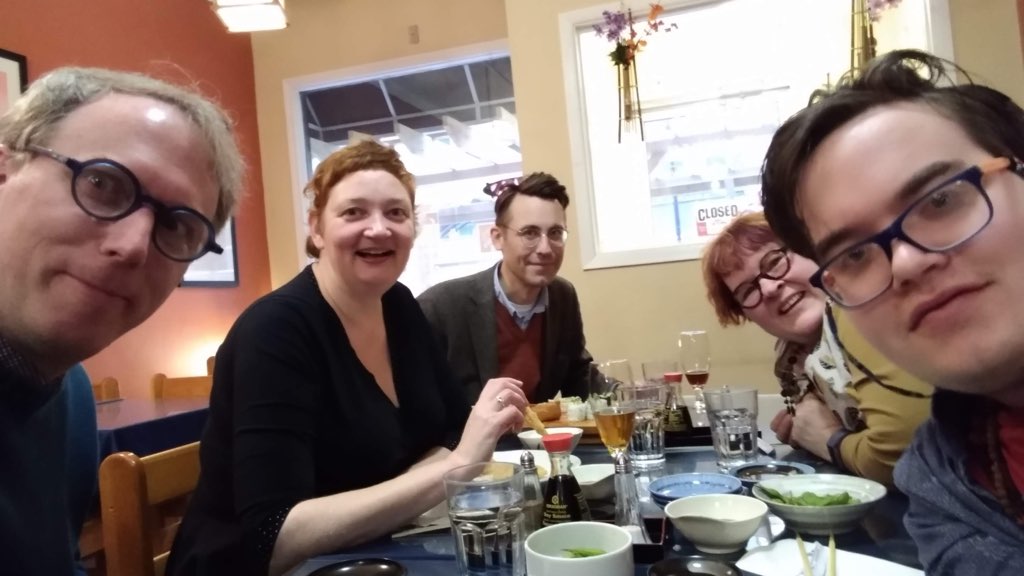
Five years is recently enough that it seems just like yesterday.
Five years is long enough that it seems like a lifetime ago.
I recognize myself in that photo: “hey, that’s me, but with different glasses.”
I don’t recognize myself at all in that photo: “oh, that’s the actor who played me in earlier seasons of the show.”
Dick York, Dick Sargent. Did anyone notice?
I’m feeling nostalgic because it’s 25 years ago today that I made my first blog post.
By happenstance, my friend Paul wandered into the coffee shop just now, and we had an interesting chat about life and death and legacy.
As a result of the conversation, I realize that, “hold on, no,” I’m more interested in what comes next than what happened to this point.
My friend Pedro wrote this in his thesis, The Way We See:
John O’Donohue defines two different time realities: surface time–where everything runs at high speed, and where our senses and perception will capture a fraction of what happens.
And the second form of time, which he calls the deep below surface time, where stillness happens and where things move slower–”if you take time not as calendar product but as actually the parent or mother of presence, then you see that, in the world of spirit, time behaves differently.”
I told Paul about how my father kept a journal every day for 53 years; for 29 of those years it was one big Word file. Here’s Dad’s “post” from May 31, 1999, the day I started blogging:
- skipped the Y
- called Paul Mudroch, he has received but not yet checked the RoxAnn map
- returned call from HP about box for printer, told them no longer an issue because to be returned
- call from library, want 2 copies of my harbour report
- spoke to Pat about moving the Port Dalhousie survey from June 28,29 to June 21,22, should be OK, Tod as coxswain
- Marilyn fanfolded the Oshawa sounder records, she will discuss Michigan GIS problems with Carolyn, left her the hard copy maps, she also noted that there was an error in the UTM coords, Carolyn had used the same grid for the four areas
- Marilyn will also check or rework Brian’s surfer files for Michigan thickness
- Marilyn willing to work some of July/August, discussed with Liz, contract will have to be revised
- told Marilyn to prepare for Tim and give him an intro to some of the work to be done
- phone message from Racca, Sting not received, was to be returned collect by FedEx, sent by truck instead, left him a message about its likely arrival date, shipped by TST Transport, our bill lading number iis 8579735, tracer number is 0016497436-3
- message from Don Woodrow, IAGLR went well, wants to speak to me about something, called and left message
- message from Peter Forbes, house proceeds will be sent to me directly
- Oshawa weather not promising but Dave has to go to move Puffin so we decided to go, left at 1000, arrived at 1140, somehow sprained my side loading the boat
- on first tv site at 1310, dead calm, worked several sites by 1430 and then ran back to marina to pick up phone
- called Maciej and left a message that I would be in tomorrow
- Dave called the Quality Inn to cancel our reservation
- continued tv survey, complete by 1545, wind now freshening but waves still small, back to marina to pick up shipek buckets, completed 9 shipek sites by 1700
- GPS check at OSHA
- at gas dock by 1725
- packed and loaded the Puffin, picked up the GPS and left at 1815
- found I had a bleeding cut on my head of unknown origin
- called Maciej again at home and left a message
- ran the Tecra on the way back to CCIW on the 12V power supply bought for the Satellites
- arrived CCIW at 2000 and unpacked
- drove Brian to Breezy Corners for pickup and had my dinner there
- home by 2130
- called Doubletree in Portland and found that we had a reservation there
- received corrected files for Michigan from Carolyn with more errors than before, printed to check the colours and emailed her about the problem
- running baudtest on the Toshiba 460 seems to clear up the problem with recognizing the second serial port
- added two more sites to those to be checked by divers at Oshawa
What if I fed 29 years of Dad’s words—supper at Breezy Corners, getting gas for the lawn mower, running baudtests—into a large language model and created a Lou Reed-style chatbot: what would chatting to that Dad look like?
I suspect it would be nothing like chatting to alive-Dad at all: none of his wit, imagination, contrarianism. None of the stuff, in other words, I’d really want.
“Did you love me?”
Like Dad’s journal, I realize this blog is, has been, mostly, about “surface time.” It’s been slices of my life: nerdy noticing, travelogues, documenting projects.
Not only, but mostly.
“I was here.”
Underneath all that, unseen, is the “mother of presence” time.
Like:
I wrote above that Paul and I “had an interesting chat about life and death and legacy.” I can imagine words like that as a bullet point in Dad’s journal. “I was here.”
But what’s missing from that is how it felt to sit here with Paul, to invite him to take a seat, have him settle in, to talk about something more and deeper than sowhatareyouuptothesedays. How it feels to have known Paul for as long as I have, the trust I have in him. How good it felt for him to say that, since Catherine’s been gone, I’ve grown in ways that he can see. How I appreciate his depth and creativity, his wisdom.
How did Dad feel on May 31, 1999? What did he and Brian talk about on the road to Breezy Corners? How did Dave feel when Dad sprained his side loading the boat? Why was he still working after he got home at 9:30 p.m.?
When I wrote about the 20th anniversary of this blog, or the 10th anniversary, my focus was analytical and nostalgic.
“I was here then, and then, and then, and then.”
I recognize the me who focused that way: there is comfort in remembering supper at Breezy Corners, and recollection of the workaday events of surface time can be a warm bath of the known and predictable.
What I resolve, though, on this day, 25 years in, is to spend more time dwelling in the places ”where stillness happens and where things move slower.”
Three years ago, about six months before I met Lisa, I read the book Needing to Know for Sure: A CBT-Based Guide to Overcoming Compulsive Checking and Reassurance Seeking, and took a photo of this passage, which I found helpful at the time:
Living Well Although Bad Things Happen and We All Die
It is possible to know that none of us gets to avoid eventual death, and that most of us suffer losses, mishaps, and mistakes, some severe-—and to still live with joy and meaning. We can know things, not deny them, and yet not become preoccupied with them. We want lasting health, lasting pleasure, lasting security, but the world is constantly changing and dynamic. Wasting time on preparing for unknown future catastrophes carries the illusion of being responsible and somehow more ready to endure what lies ahead.
I didn’t know it at the time, but that notion served as a pathway for me; it is, in a way, the central point around which most discussions, both inside my head and out, focus.
It’s a notion, too, that has served me well in building a life together with Lisa: she is an excellent partner in pursuit both of living well, and finding the places where stillness happens; indeed it’s the tensions between those points on the compass that make our life together interesting.
Because I know that, regardless of my intentions, the pull to nostalgia will forever be part of me, here’s a note to my future self: on this 25th blogaversary you are having a good day. The sun is shining. You had an excellent breakfast. You woke up with the woman you love. You are having lunch with your brother. You are living well. There is a taste of the stillness you seek. You are here.
Brooklyn Bridge is the first track on Anaïs Mitchell’s self-titled 2022 album.
I’ve listened to the song a dozen times today, since it algorithmically showed up in Spotify’s Discover Weekly, sandwiched between In Your Circle (by Aaron Percy and judah mayowa) and Indiana (by Adrianne Lenker).
Somehow, on this day, it scratches what’s itching me. The lyrics aren’t profound — the heart is the phrase “everything I want,” which is sung 36 times — but it builds and dips and hangs together and, well, it’s just delicious.
Be sure to listen to this live recorded version, and this performance at Les Etoiles Paris from late 2022, which is perhaps my favourite.
Speaking of people named Anaïs and Paris (you had to see that coming), I am reminded of the time, I was confounded by (and then redeemed from) the task of setting a line from an Anaïs Nin’s diary:
In Paris, when entering a room, everyone pays attention, seeks to make you feel welcome, to enter into conversation, is curious, responsive. Here it seems everyone is pretending not to see, hear, or look too intently.
What a lovely line that is, that.
Anaïs Nin, like Anais Mitchell, was a polymath.
Mitchell, for example, developed the Broadway show Hadestown, about which she wrote a book.
Nin was a “diarist, essayist, novelist, and writer of short stories and erotica,” but what is often left out of her biography is that she was a letterpress printer. From The Intimate Books of Anaïs Nin – Diarist as Letterpress Printer, by Emily Larned:
What is less known about Nin is that she was a habitual self-publisher. Throughout her life, she would continuously, obsessively republish a text once it had fallen out of print, creating many different books from one text. The poet and printer Alan Loney distinguishes between the words “text” and “book.” Although the terms are often used interchangeably in English, an author’s text (her words) is mutable of form. This slippery, shape-shifting text is contrasted with the particular material specificities of a physical book. It is these nontextual qualities—the paper, the type, the margins, the size and shape—Loney explains, that he found so compelling. Today when a contemporary reader finds a book by Nin, it is often a slim, inexpensive paperback printed on cheap paper, with a glossy, ill-designed cover strewn with garish colors and art deco type. How different this reading experience is from hovering over the dark, hushed, carefully made letterpress editions produced by Nin’s own hands.
From Nin’s own words, in The Diary of Anaïs Nin, Vol. 3: 1939-1944:
The relationship to handcraft is a beautiful one. You are related bodily to a solid block of metal letters, to the weight of the trays, to the adroitness of spacing, to the tempo and temper of the machine. You acquire some of the weight and solidity of the metal, the strength and power of the machine. Each triumph is a conquest by the body, fingers, muscles. You live with your hands, in acts of physical deftness.
You pit your faculties against concrete problems. The victories are concrete, definable, touchable. A page of perfect printing. You can touch the page you wrote. We exult in what we master and discover. Instead of using one’s energy in a void, against frustrations, in anger against publishers, I use it on the press, type, paper, a source of energy. Solving problems, technical, mechanical problems. Which can be solved.
Oh my that’s it, exactly it.
Anaïs Mitchell was, as you might imagine, named after Anaïs Nin; from SPIN:
Because she is my namesake, I read all the diaries and even the erotica when I was quite young. I just wanted to find out what she was about, and I had very little actual life experience with which to understand what she was writing about. I adore Anaïs Nin’s writing. I find it so delicate and brave and when I think about how extraordinary it was, her commitment to her art and to the life experience she was determined to go out and get (including her many affairs), it’s quite overwhelming. She was so wildly powerful and also so vulnerable.
From the bridge of Brooklyn Bridge:
I wanna be someone
Wanna be one in a million
I wanna be the one you want
I wanna be one of a kind
I wanna be once in a lifetime
Wanna be the one you ride beside
That’s it too.
After putting out the patio furniture yesterday, this morning was our first opportunity to eat breakfast outside on the deck. It was chilly, and the gathering storm clouds suggested rain, so we moved inside for quiet reading time, but it was delightful nonetheless.
The new Salman Rushdie book was, by some miracle, available at the public library, despite only having been published a month ago.
This conversation between Mike Birbiglia and Judd Apatow is fascinating: I leaned a lot about the creative process, how movies get produced (and what a producer does). and about how much effort creating a compelling movie takes.
”Every script needs a friend,” is a line I will remember.
As is this passage from Apatow about the incurious (which recalls this post from last year):
You know, because we know so many people, they’re so funny and they’re so neurotic, and then you’ll leave them after two hours and realize they never asked me a question, right, and you were just servicing them in some way the entire time right, which I don’t mind cuz some of those people, they’re magic, they’re broken, but they’re magic, and it’s fun, and it’s worth it, but there are times where you go ‘that’s just so interesting that they don’t have any curiosity.’”
Last week in Florence we went looking for Il Bisonte Foundation, a printmaking school in the neighbourhood we were staying.
We walked to Via San Niccolò 24, and… no printmaking school.
This is how we discovered that in Florence there are two sets of street numbers, black, for residences, and red, for commercial addresses.
We walked up the street a little to 24r and ended up having a lovely conversation and tour with curator Silvia Bellotti.
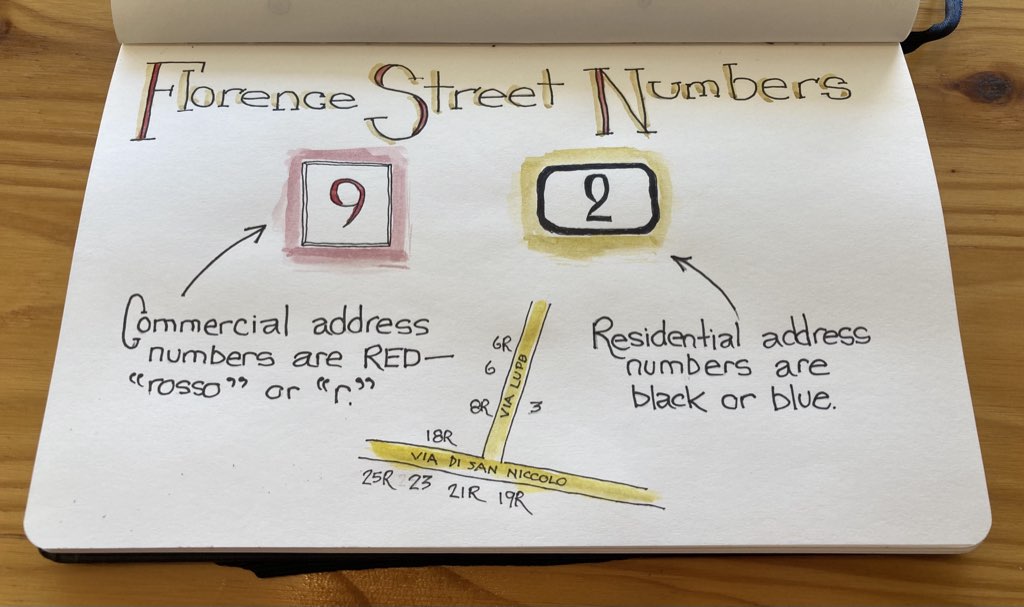
Lisa often marvels that about the things I ignore (often large and obvious things) and the things I notice (often small and insignificant things); one of the small things I noticed on the walk to Il Bisonte was a tiny plaque on the Torre San Niccoli:
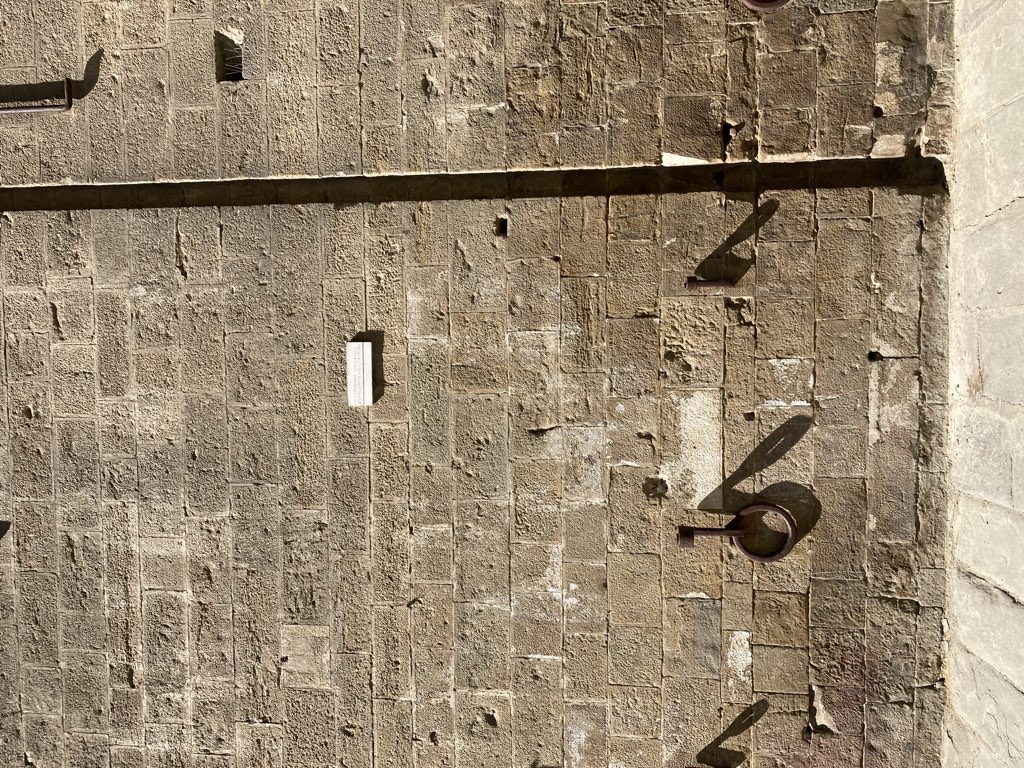
The plaque says:
Il 4 Novembre 1966 l’acqua d’Arno arrivo a quest altezza
or, in English:
On 4 November 1966 the Arno water reached this height
The Arno is the river that runs through the heart of Florence and, we learned from Wikipedia, it flooded its banks in 1966, a cataclysmic event in the city:
The 1966 flood of the Arno in Florence killed 101 people and damaged or destroyed millions of masterpieces of art and rare books. It is considered the worst flood in the city’s history since 1557. With the combined effort of Italian and foreign volunteers alike, or angeli del fango (“Mud Angels”), many of these fine works have been restored. New methods in conservation were devised and restoration laboratories established. However, even decades later, much work remains to be done.
Later, during our tour of Il Bisonte with Silvia, I asked her if the Foundation had always been in the space she was showing us at 24r.
No, she told us, the after being founded elsewhere, the Foundation moved into its current space in… 1966. A few months before the flood. As described on the Foundation website:
The 4th of November 1966 was a turning-point in the history of Il Bisonte, the premises of which had just been moved to the old district of San Niccolò, where they are located still to this day. The premises were submersed by the Arno flood, Guaita saved herself by escaping through a window, and many works were badly damaged or even lost.
Silvia pointed out to us the same plaque on the wall inside their offices, showing the high water mark from November 4, 1966, which illustrated more than anything else how overwhelming the flood must have been:
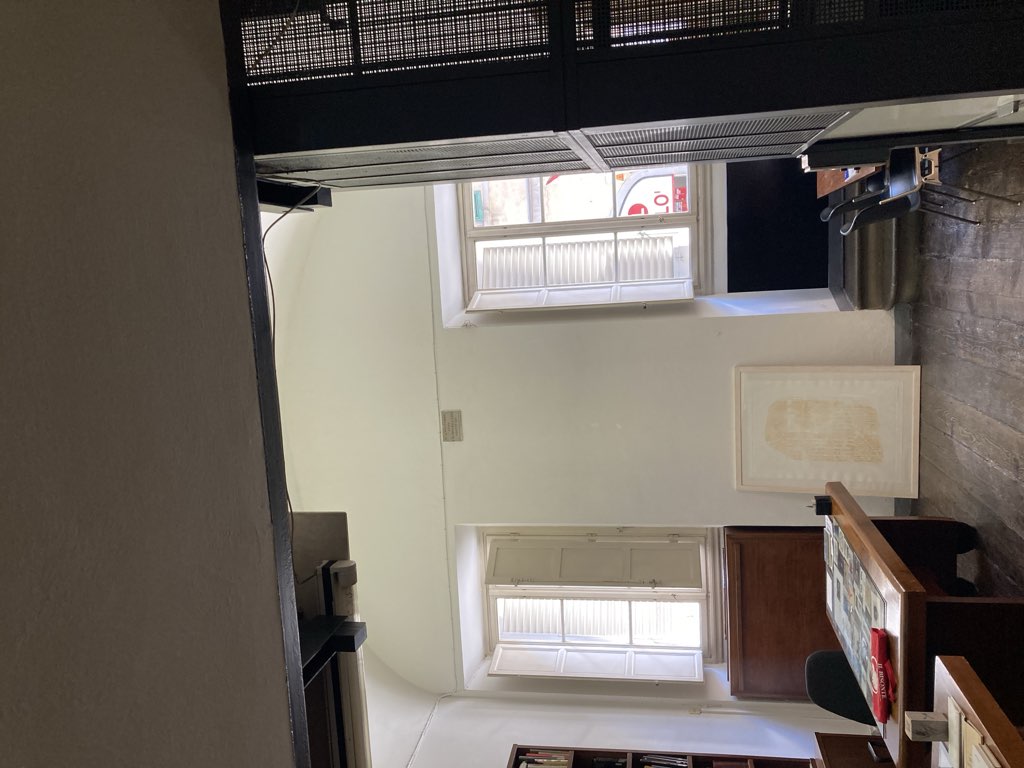
One of the silver linings in the flood of Il Bisonte is that founder, Maria Luigia Guaita, reached out to artists around the world for support, and one who responded was Henry Moore:
Numerous artists offered their help in order to restore the activity of the printing house. Among them, Henry Moore realised famous etchings around the theme of the human figure. In 1972 Guaita managed to organise the first exhibition of Moore’s sculptures at the Forte Belvedere, and in that same period Il Bisonte hosted an exhibition of his graphic production.
Some of Moore’s work, along with those of many other printmakers, renowned and not, grace the walls of the Il Bisonte library:


Remember how I often notice small things and miss the big ones: it’s only now that I realize that, in English, Il Bisonte translates to The Bison. This serves to explain the frequent bison references I saw on the tour, including this one in the workshop:
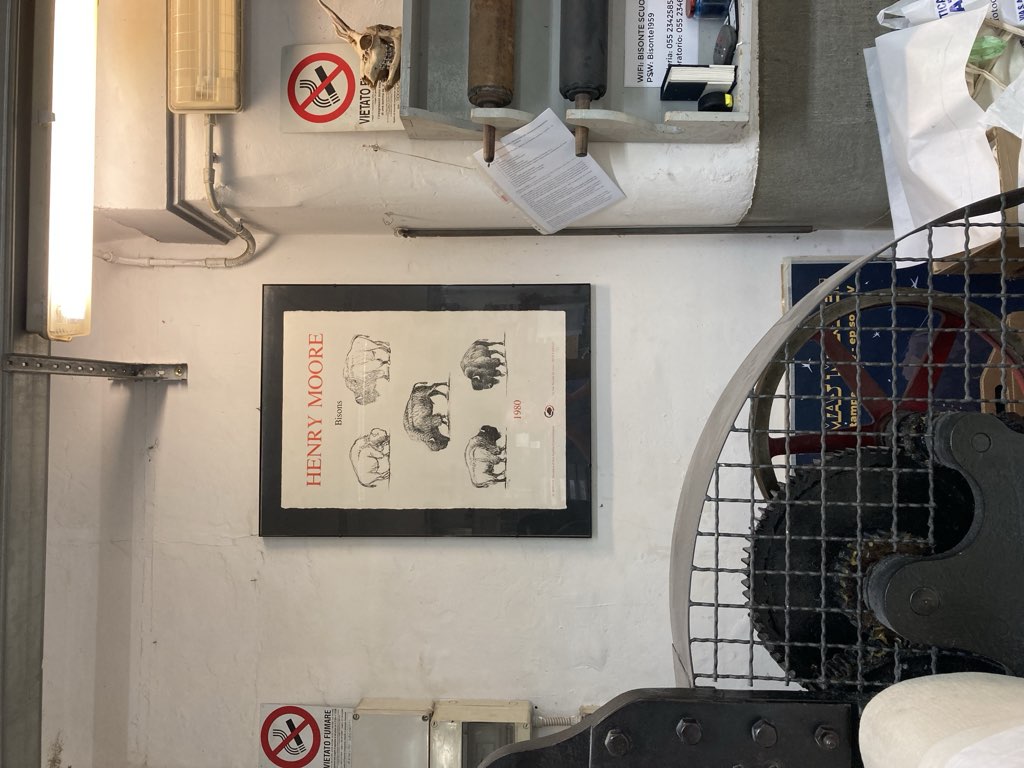
Winnie Lim, in a recent post, quotes Oliver Burkeman from You Can’t Hoard Life:
Spending your days trying to get experiences “under your belt”, in an effort to maximise your collection of experiences, or to feel more confident about the future supply of similar experiences, means placing yourself in a position from which you can never enjoy them fully, because there’s a different agenda at play.
When I think about our month in Europe, it’s times like our afternoon at Il Bisonte that I remember most fondly, experiences that simply emerged slowly from wandering and paying attention. We were at our worst when we did what Burkeman describes as clenching — “an attempt to grasp the moment and bring it under my ownership” — relentlessly trying to pursue things (the perfect place to stay, the perfect restaurant, the perfect view, the perfect thing to see in any given city).
We visited Florence. We didn’t visit David. We didn’t tour the Uffizi. We didn’t climb the Duomo.
But we learned about two sets of street numbers, had a lovely tour of a printmaking school, and learned about a singular event in the city’s history. That is how I love to travel.
The first time I went to Europe as an adult, in 1998, I carried my money in travellers cheques, and mostly dealt in cash (after cashing them in, in dribs and drabs, over the trip). I was able to withdraw cash from ATMs along the way too, and sometimes use my Mastercard (although not always: some places only took Visa). I repeated this on a trip, around the same time, to South Korea, to visit my brother Steve, and in that case I actually lost the travellers cheques, as a result of a jet lagged stumble in Seoul, and had them refunded at the Thomas Cook office, which was exactly travellers cheques value proposition (it was as easy and seamless as the TV commercials made it out to be).
A decade later, in the heart of my heavy European travel jag, I’d shifted almost entirely to withdrawing cash from ATMs, paying for things like hotels with my Mastercard. This was still occasionally an issue: I recall the paying for certain things, especially train tickets, in Sweden and Denmark, wasn’t possible with a Canadian credit card.
Now, a quarter century into travel to Europe, our trip to Sweden, Denmark, The Netherlands, and Italy, was almost entirely cashless: I used my Mastercard (most often via Apple Pay on my Phone) for almost everything, with just a few exceptions (for things like an off-the-books extension of an Airbnb rental, paying tourism taxes, feeding parking machines). I made two ATM withdraws in 30 days.
One of the side-effects of using the same card for everything is that getting an overview of how much I spent on the trip, and on what, is as easy as downloading a CSV of my Mastercard statement into a spreadsheet and running a pivot table over it, using the automatically-assigned purchase categories:
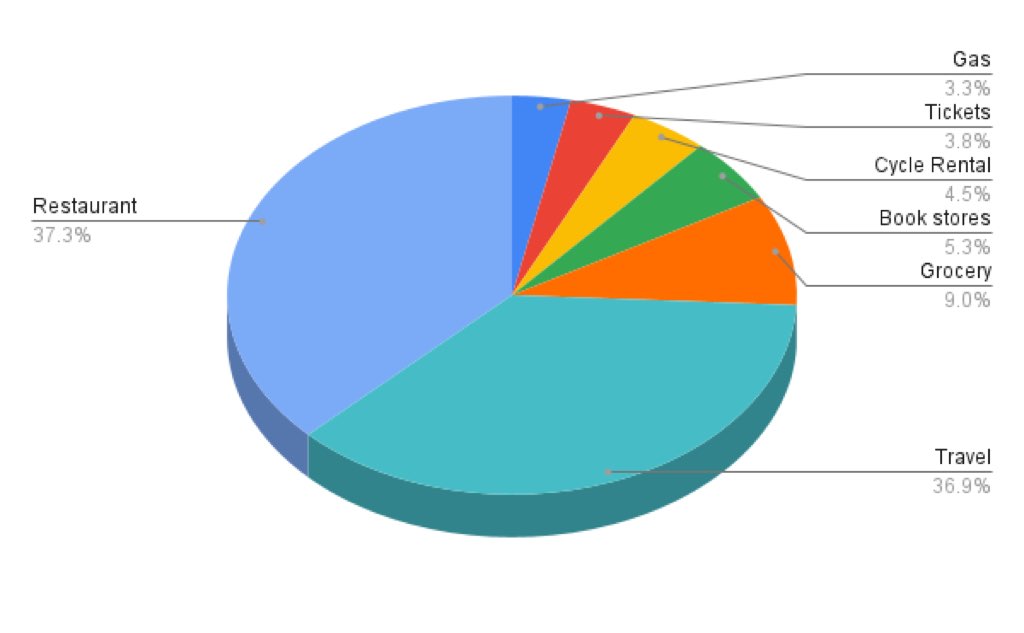
 I am
I am